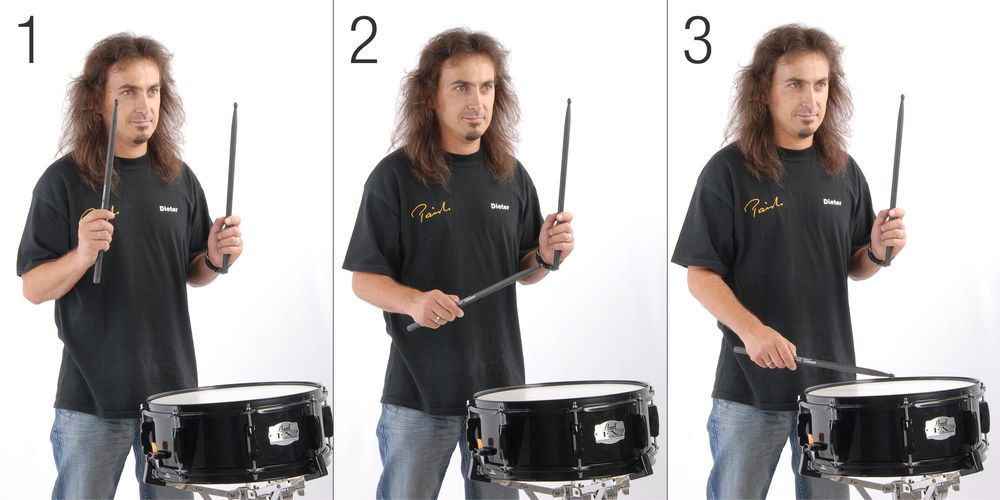9. Rudiments and Basic Strokes
In order to play a snare drum well, drummers need a solid technical foundation. Rudiments are sticking patterns made up of different combinations of notes that serve as the drummer's alphabet. By learning these patterns drummers can play a wide variety of musical styles, and do it with finesse and musicality. While rudimental drumming has its origin in Europe, North American drummers have embraced the style and technique of rudimental drumming and have developed it to its technical extreme in Drum Corps Marching bands. These Drum Corps drummers often combine rudiments or create completely new ones called "hybrid rudiments", specifically for the fun and challenge of mastering them. Knowledge of rudiments will help any drummer; kit players can benefit greatly by learning them since they will gain good control of their hands in the process. Learning to apply rudiments to the drum kit musically is one of the things that sets great drummers apart. In fact, one of the biggest mistakes a drummer can make is having no technical foundation whatsoever.
Full Stroke
There are many ways to develop your technique, some more efficient than others. Learning the basic motions used in the execution of rudiments can speed the process. For many years, it was common practice to teach larger motions involving the arms prior to those involving the wrists. Only after the arms and wrists and had been taught were students instructed in the use of the fingers.
If you throw a ball to the floor it will bounce back up quickly. Like a ball, a stick can bounce upwards much faster than you can lift it. The full stroke is a great way to learn how to get a stick to rebound or bounce.
- The initial position is as follows: Both are angled slightly upwards at approximately 60-70 degrees, with the elbows near the body. The sticks point upwards and are approximately 10-15cm apart.
- The stroke consists of a rotating motion using the upper and lower arm. While bringing the hand down, the elbow moves away from the side of the body. Both hand and elbow must operate in tandem for the motion to be fluid.
- This movement continues until the back of the hand is in a horizontal position and the drumstick momentarily contacts the drumhead. At this point the stick should be allowed to rebound freely back to the starting position without being impeded by the fingers. The return motion for the arm is simply the same thing in reverse.
For this stroke the wrist and fingers do not move though the wrist follows the arm motion. It is useful for beginners to learn the stroke without wrist movement so that the general motion can be mastered and bad habits can be prevented. Once this stroke is learned the use of the wrist can be explored. A disadvantage of this approach is that the use of the fingers is ignored.
The full stroke described above is useful for playing very loud passages of music. Playing quietly does not work well using a full stroke unless the range of the stroke becomes smaller. Reducing the range of the motion will result in quieter dynamics, though the basic movement remains the same. From this large arm motion you will eventually learn to transition to the smaller and quicker motions of the wrist. The motion of the wrist is fundamentally the same as that of the arm but yields a softer volume. Eventually learning the use of the fingers allows for even quieter dynamic levels to be achieved.
This approach uses many groups of upper and lower arm muscles. In general you should maintain maximum control of the sticks at each volume level with the minimum expenditure of energy. Having a smooth motion at every dynamic level is one of the goals of every serious drummer.
Down Stroke
The down stroke is basically the first half of a full stroke. The motion begins the same as a Full Stroke, but after striking the drum the stick is immediately stopped just above the drumhead, remaining parallel to it. The fingers are used to keep the stick from rebounding upwards. This stroke is essential for playing musical passages that have sudden dynamic changes from loud to soft. Stopping the stick low enables drummers to play soft notes after loud ones.
Up Stroke
The up stroke is essentially the second half of a full stroke and involves playing a low note and then returning the arm to the full stroke position. Returning the stick to a high angle allows drummers to play loud notes after soft ones.
Tap Stroke
Tap Strokes are essentially very small full strokes in that the stroke begins at a low height and rebounds to the same height without the fingers impeding the motion. Tap strokes are used to play repeating soft notes.
What should I do with these four strokes?
These strokes can now be used to learn drum rudiments. A few essential rudiments that are used in many styles of music and are also components of most of the longer rudiments include the following (R = right hand stroke, L = left hand stroke):
- Single stroke roll: one note per hand (R-L-R-L), all played as full strokes.
- Double Stroke Roll: two notes per (R-R-L-L), played as down stroke (R), up stroke (R), down stroke (L), up stroke (L).
- Paradiddle: played with the following sticking R-L-R-R L-R-L-L, consisting of a down stroke (R), up stroke (L), tap stroke (R), tap stroke (R), followed by a down stroke (L), up stroke (R), tap stroke (L), tap stroke (L).
Play these patterns slowly and evenly at first and only increase the speed after the motions are mastered.


